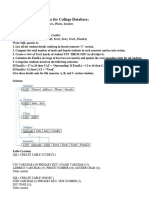0% found this document useful (0 votes)
23 views15 pagesAmazing MySQL Interview Preparation
The document provides a comprehensive list of over 100 MySQL interview questions and their answers, covering topics from basic SQL commands to more advanced concepts like normalization, transactions, and performance optimization. Each question is paired with a concise answer, often including example SQL queries. This resource serves as a valuable tool for individuals preparing for MySQL-related interviews.
Uploaded by
sharath.sCopyright
© © All Rights Reserved
We take content rights seriously. If you suspect this is your content, claim it here.
Available Formats
Download as TXT, PDF, TXT or read online on Scribd
0% found this document useful (0 votes)
23 views15 pagesAmazing MySQL Interview Preparation
The document provides a comprehensive list of over 100 MySQL interview questions and their answers, covering topics from basic SQL commands to more advanced concepts like normalization, transactions, and performance optimization. Each question is paired with a concise answer, often including example SQL queries. This resource serves as a valuable tool for individuals preparing for MySQL-related interviews.
Uploaded by
sharath.sCopyright
© © All Rights Reserved
We take content rights seriously. If you suspect this is your content, claim it here.
Available Formats
Download as TXT, PDF, TXT or read online on Scribd
/ 15





























































































